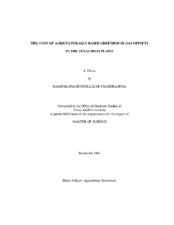The cost of agriculturally based greenhouse gas offsets in the Texas High Plains
Date
2004-09-30Metadata
Show full item recordAbstract
The broad objective of this thesis involves investigation of the role agriculture might play in a society wide greenhouse gas emissions reduction effort. Specifically, the breakeven price for carbon emission offsets is calculated for agriculturally based emission reducing practices. The practices investigated in the Texas High Plains involve reduced tillage use, reduced fallow use, reduced crop fertilization, cropland conversion to grassland, feedlot enteric fermentation management and digester based dairy manure handling. Costs of emission reductions were calculated at the producer level.
The calculated offset prices are classified into four cost categories. They are: negative cost, low cost (less than $20 per ton of carbon saved), moderate cost ($20 through $100 per ton of carbon saved), and high cost (over $100 for tons of carbon saved).
Negative cost implies that farmers could make money and reduce emissions by moving to alternative practices even without any carbon payments. Alternatives in the positive cost categories need compensation to induce farmers to switch to practices that sequester more carbon.
All fallow dryland crop practices, dryland and irrigated cotton zero tillage, dryland and irrigated wheat zero tillage, irrigated corn zero tillage, cotton irrigated nitrogen use reduction under minimum tillage and dryland pasture for all systems, and anaerobic lagoon complete mix and plug flow systems fall in the negative cost category.
Dryland and irrigated wheat under minimum tillage are found to be in the low cost category. Cotton dryland under minimum tillage and cotton irrigated with nitrogen use reduction under zero tillage fell into the moderate cost class. Both corn and cotton irrigated minimum tillage are found to be in the high cost category.
This study only considers the producer foregone net income less fixed costs as the only cost incurred in switching to an alternative sequestering practice. More costs such as learning and risk should probably be included. This limitation along with other constraints such as use of short run budget data, lack of availability and reliability of local budgets, overlooking any market effects, and lack of treatment of costs incurred in selling carbon offsets to buyers are limitations and portend future work.
Subject
Agriculturally based greenhouse gas offsetsBreakeven carbon price
Producer development cost
Texas High Plains
Carbon sequestration
Citation
Chandrasena, Rajapakshage Inoka Ilmi (2003). The cost of agriculturally based greenhouse gas offsets in the Texas High Plains. Master's thesis, Texas A&M University. Texas A&M University. Available electronically from https : / /hdl .handle .net /1969 .1 /85.


